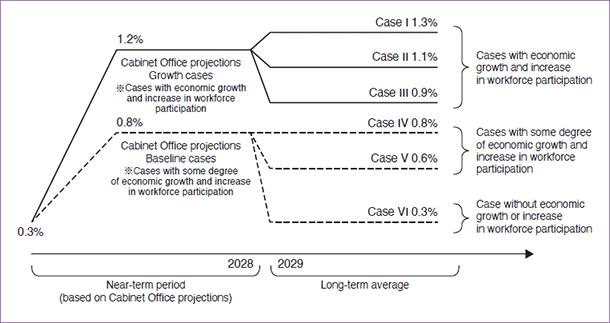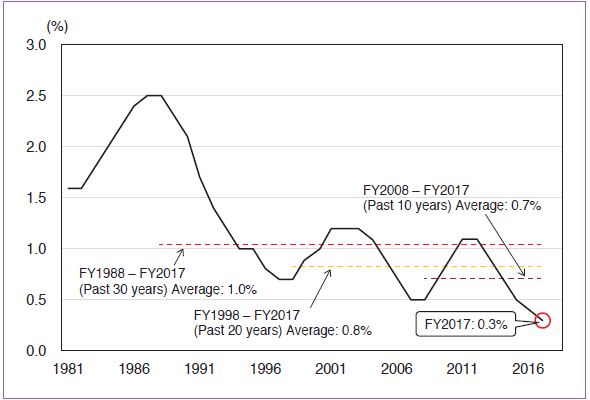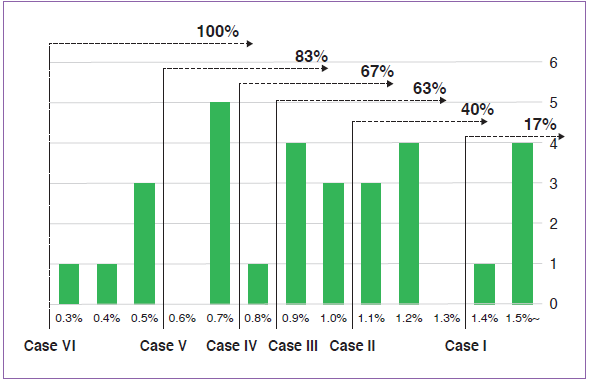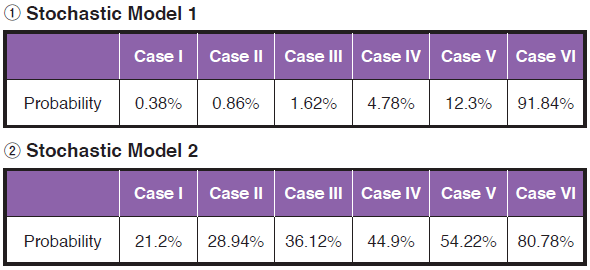PDF version [PDF:442KB]
Introduction
I recently edited a compilation of essays under the title Demographic Changes and the Design of Public Finances and Social Security Structures (Nippon Hyoron Sha, 2021). The book is a compilation of the results of a project called Research Related to Demographic Changes and the Design of Public Finances and Social Security Structures, carried out by the Hosei University Institute of Comparative Economic Studies from fiscal 2017 to fiscal 2020, with members including Keio University Professor Keiichiro Kobayashi. The project searched for clues as to how to reform fiscal policies and social security and eliminate gaps across generations, using both positive economic analysis and theoretical economic analysis, including trends in reforms of election systems and fiscal oversight. The book comprises 11 chapters, grouped as Part I: Democracy and Public Finances; Part II: Reform of the Social Security Structure; and Part III: Demographic Changes and Markets.
It will not be possible to give an overview of all three parts in this article, but I will, for example, discuss Japan's public finances from the perspective of governance while touching on the main theories and debates surrounding public finance by highlighting the changes in economies and public finance in recent years in major advanced countries contained in Chapter 1, Democracy and Fiscal Governance.
Following the global financial crisis and with the more recent Covid-19 pandemic, OECD countries have continued to increase their issuance of government debt to unprecedented levels, and today there is increasing debate among researchers globally as to whether fiscal policy should be expansive or contractive.
In addition to the perspective of macro fiscal policies, micro budget-making processes have gained importance in recent years, and many data-based analyses are pointing to a need to reform budget-making processes to rein in fiscal deficits and debt. Japan has made repeated attempts at fiscal restructuring, but almost all have been failures. This is because of budget-making processes that lack transparency, and fiscal governance problems. Fiscal governance is not simply a matter of reducing fiscal deficits and debt; there are also governance problems with the financial verification of the national pension program that I will introduce later in this article.
Chapter 11, Aging in East Asia and Rethinking Financial Markets, uses time series and panel data to estimate the effects of demographic change on macroeconomic variables. The results contain significant implications, suggesting that as a population ages, interest rates rise and returns on equities decline. These results are limited to countries with a low degree of financial openness, however, and if the degree of financial openness increases, the effect of demographic changes on interest rates and equity returns diminishes. In addition, overseas savings replace domestic savings, which pushes savings rates lower. It would be rational to assume that the amount of savings would increase if the pace of aging is forecast to accelerate, but empirical analysis shows that a "forecast of an accelerating pace of aging" has a significant effect on reducing savings, while on the other hand bringing about lower interest rates and higher equity prices.
This "puzzle" can be explained by the fact that an accelerating pace of aging means there will be a major shift in asset demand from physical assets to liquid financial assets, raising prices of financial assets and reducing returns. Panel data-based estimates also show a strong correlation between an accelerating pace of aging with increased demand for financial assets and a reduction in investment in physical goods. These findings can explain the phenomenon of "savings postponement" associated with the "time inconsistency" concept in behavioral economics, and have already been introduced in Europe and the United States as pension systems that promote savings based on behavioral economics, known as "saving more tomorrow", to address shortfalls in post-retirement assets. As with the "20-million-yen shortage for life in post-retirement problem" in Japan, there is a possibility that East Asian countries with aging populations will face shortfalls in post-retirement assets, creating the need for financial and pension systems that use behavioral economics to create a "nudge" effect.
2019 Financial Verification of the National Pension Program
This becomes important for the expansion of defined contribution pension plans like the individual-type defined contribution pension plan (iDeCo) and the Nippon Individual Savings Account (NISA), but public pensions are expected to be the foundation that provides the funds for daily life in old age. The book's Chapter 5, Considerations Related to the 2019 Financial Verification and Pension Finances, analyzes and considers pension finances, including what form fiscal governance should take. The following is somewhat long, but gives an overview of Chapter 5.
First, given its rapidly aging population and declining birthrate, Japan in particular is seeing an increase in the number of people expressing doubts as to whether they will really be able to live into old age by relying only on their public pension. This is the "20-million-yen shortage for life in the post-retirement problem" noted above, and the answer is made clear in the 2019 "financial verification".
As is well known, the financial verification is to check the health of public pension finances and by law must be carried out at least every five years. The results of the most recent verification were announced by the Ministry of Health, Labour and Welfare on Aug. 27, 2019, with the release of the document "Current Status and Forecasts for Public Finances Related to the National Pension and Employees' Pension Insurance".
These projections factor in economic growth in the forms of workforce and capital, as well as other gains in productivity. Productivity is called Total Factor Productivity (TFP), and it is not an overstatement to say that the major portion of economic growth is determined by the increase in this TFP. In the 2014 financial verification, the trajectory of the economic growth rate was determined using eight different conditions including nominal investment returns and real wage growth (Cases A–H) in addition to the rate of increase in TPF, but the most recent (2019) financial verification was determined using six cases (Cases I–VI) (Chart 1).
In the pension reform of 2004, the government legally mandated that the income replacement ratio (the pension benefit level for a model household relative to the average take-home income of a working male) be maintained at 50% at least, and that the system needed to be revised if the ratio fell below 50%, but as shown in Chart 2, in the 2019 financial verification, in all three of the high-growth scenarios (real GDP growth rates of 0.4% to 0.9% from fiscal 2029), the current replacement ratio of 61.7% fell to 50.8-51.9%, meaning that the benefit level would be approximately 20% lower in roughly 30 years.


Source: Compiled by the author, based on Reference Material 2-1 "Current Status and Forecasts for Public Finances Related to National Pension and Employees' Pension Insurance – Results of 2019 Financial Verification" of the 9th meeting of the Ministry of Health, Labour and Welfare's Social Security Deliberation Council's Pension Committee (held on Aug. 27, 2019)
Furthermore, the replacement ratio fell below 50% in the three low-growth (real GDP growth rates of -0.5% to +0.2% from fiscal 2029) scenarios, and in Case VI the reserves in the National Pension Fund would be used up by fiscal 2052, meaning a shift to a full pay-as-you-go system and the clear possibility of a replacement ratio of 36% to 38%.
Of these six scenarios, then, which is the most likely to occur? Of course, judging the appropriateness of each scenario requires information like the underlying assumptions of the financial verification (e.g., rate of TFP increase) and the probability of each scenario, but currently the government does not release this type of official forward-looking forecast.
There was no information on the underlying assumptions and probability of various scenarios in the 2019 actuarial valuation either, but the core primary parameters (e.g., rate of TFP increase, rate of price increases, rate of wage increases, investment returns) were included in the official materials as a frequency distribution (histogram) based on historical data that showed where in the frequency distribution the underlying assumptions for each scenario were located and what percentage was covered in the frequency distribution [Note: refer to pages 26, 38-40, and 63 of Reference Material 2: Economic Assumptions Underlying the Financial Verification (the "Reference Materials Collection") of the Meeting of the Specialist Committee on Economic Assumptions for the 10th Financial Verification (held on March 7, 2019) of the Ministry of Health, Labour and Welfare's Social Security Deliberation Council's Pension Committee (the "Reference Collection")].
The economic assumptions for the 2019 financial verification referenced things including the historical rate of TFP increase (Chart 3), and set six scenarios for the rate of TPP increase from fiscal 2029 onward: Case I – 1.3%; Case II – 1.1%; Case III – 0.9%; Case IV – 0.8%; Case V – 0.6%; and Case VI – 0.3%.

Probability of 6 Scenarios Occurring & Future of the Pension System
The appropriateness of each scenario is explained as follows using the distribution of historical rates of TFP increase [Note: refer to page 6 of Reference Material 1: Proposed Economic Assumptions for Financial Verification (the "Report on the Results of Examination") of the Meeting of the Specialist Committee on Economic Assumptions for the 10th Financial Verification (held on March 7, 2019) of the Ministry of Health, Labour and Welfare's Social Security Deliberation Council's Pension Committee (the "Proposed Report")].
The assumptions for the long-term (fiscal 2029 onward) rate of TFP increase are set within a range of 0.3% to 1.3%. The actual range for the latter half of the 1990s, after the bursting of the economic bubble, is estimated as 0.3% to 1.2%, and the assumptions were basically set using that range. In terms of distribution of actual results over the 30 years from fiscal 1988 to 2017, the Case I assumption of 1.3% covered roughly one-fifth (17%), meaning that Case I corresponded to the actual results in roughly one-fifth (17%) of the years during the 30-year period. Similarly, the Case II scenario of 1.1% covered roughly two-fifths (40%), Case III's 0.9% covered roughly three-fifths (63%), Case IV's 0.8% covered roughly seven-tenths (67%), Case V's 0.6% covered roughly four-fifths (83%), and Case VI's 0.3% covered all (100%).
The assumptions for the long-term (fiscal 2029 onward) rate of TFP increase are set within a range of 0.3% to 1.3%. The actual range for the latter half of the 1990s, after the bursting of the economic bubble, is estimated as 0.3% to 1.2%, and the assumptions were basically set using that range. In terms of distribution of actual results over the 30 years from fiscal 1988 to 2017, the Case I assumption of 1.3% covered roughly one-fifth (17%), meaning that Case I corresponded to the actual results in roughly one-fifth (17%) of the years during the 30-year period. Similarly, the Case II scenario of 1.1% covered roughly two-fifths (40%), Case III's 0.9% covered roughly three-fifths (63%), Case IV's 0.8% covered roughly seven-tenths (67%), Case V's 0.6% covered roughly four-fifths (83%), and Case VI's 0.3% covered all (100%).
Further explanation is required to understand the numbers used in the explanation of the Proposed Report. Let us consider Case III, with a 0.9% increase as the rate of TFP growth.
First, the meaning of "In terms of distribution of actual results over the 30 years from 1988 to 2017. . . Case III's 0.9% covered roughly three-fifths (63%)" is easier to understand if we look at the frequency distribution for the historical rate of TFP increase. Page 26 of the Reference Collection shows the frequency distribution for the rates of TFP increase over the past 30 years (fiscal 1988 to fiscal 2017) (Chart 4), and within that distribution, the rate of TFP increase was 0.9% or higher for 63% of those years. This is what is meant by "Case III's 0.9% covered roughly three-fifths (63%)."

This does not, however, mean that the Case III scenario will definitely be achieved 63% of the time. Even if we assume that the distribution of the rate of TFP increase going forward will be unchanged from the distribution to date, the Case III scenario is not certain to be achieved 63% of the time. The reason is simply that Case III assumes that the rate of TFP increase from fiscal 2029 onward is certain to be 0.9% or higher every year, and if it falls below 0.9% in even one year, the underlying assumption for Case III will not be met.
This can be clearly understood using the following simple case. If the rate of TFP increase in the first year is 0.9% or higher, what is the probability of the rate being 0.9% or higher in the second year? If we assume that the random variable for the rate of TFP increase in each year is independent, the correct probability is 39.7% (= 0.63 x 0.63). In other words, the figure of 63% shows the probability of the rate of TFP increase being 0.9% or higher in a particular year, but does not indicate the probability of the rate being 0.9% or higher in every year from fiscal 2029 onward.
The frequency distribution shown in Chart 4 was not included in previous (to 2014) financial verification, and while we should evaluate this approach, the frequency distribution coverage rate is not necessarily consistent with actual probabilities for things like the rate of TFP increase used as underlying assumptions for the financial verification. Is it not possible to leave the defined underlying assumptions in place, and make an evaluation of the assumptions for the rate of TFP increase in each case for the 2019 financial verification?
I have used the data for the historical rate of TFP increase going back more than 30 years to construct a simple stochastic model, and applied a Monte Carlo simulation to estimate the probability of achieving the rates of TFP increase used in each of the cases in the 2019 financial verification.
The details of the estimation method are outlined in Chapter 5, but the estimated probability of (the rate of TFP increase in) each scenario using Stochastic Model 1 and Stochastic Model 2 are shown in ① and ② in Chart 5 above.
What can we take from ① and ② in Chart 5? First, there is a significant difference between the coverage rates for Cases I-IV in Chart 4 with the probabilities derived in Chart 5. This means that the coverage rates shown in Chart 4 are not consistent with the actual probabilities for the rates of TFP increase that form the underlying assumptions in the financial verification.
In addition, if we use Stochastic Model 1 as the underlying assumption, according to Chart 5 ①, the probability of achieving the rate of increase in Cases I-IV is less than 5%, and even in Case V is still low at roughly 12%. Only in Case VI is the probability approximately 90%.

These are extremely discouraging results. After all, in the pension reforms of 2004, the government clearly mandated that the pension system's replacement ratio be maintained at 50% at least in the future, and that if it fell below 50% the system needed to be revised. Nevertheless, as noted above, in the three low-growth (real GDP growth rates of -0.5% to +0.2% from fiscal 2029) scenarios of the 2019 financial verification (Cases IV-VI), the replacement ratio is less than 50%, and in Case VI the reserves in the National Pension Fund would be used up by fiscal 2052, along with the clear possibility of a replacement ratio of 36% to 38%.
Based on these results from the 2019 financial verification, the fact that Case VI is the only one for which the probability of achieving the rate of TFP increase is roughly 90% suggests the possibility of a very difficult future for the national pension system.
The preceding paragraphs deal with the assumptions drawn from Stochastic Model 1, and things change if we use Stochastic Model 2. Using the assumptions resulting from Stochastic Model 2, as shown in Chart 5 ②, the probability of achieving the rates of TFP increase rises to roughly 20%–36% for Cases I-III. As in Chart 5 ①, the probability is highest for Case VI, this time at roughly 80%, and for Case IV and Case V rises to roughly 45%–54%.
Compared with the final replacement ratio of less than 40% in Case VI, in the end the replacement ratio can be maintained at slightly less than 50% in Case V and Case VI, meaning that if the rate of TFP increase assumed in Case V and Case VI can be achieved, the replacement ratio would be roughly 1.2 times as high as otherwise.
In addition, ① and ② in Chart 5 show that which stochastic model is used to evaluate the underlying assumption for the rate of TFP increase used in the financial verification changes the probability of achieving the rate of TFP increase. This means that it is important to interpret these results with some latitude, but even using the assumptions derived in Chart 5 ②, we have to frankly admit that the probability of achieving Case I or Case II is less than 30%.
In general, public annuity insurance is an insurance that, with life expectancy being an unknown variable, shares the risk of people facing poverty if they live longer than expected (or having assets left over if they die unexpectedly early). The framework has an important function of protecting people from poverty as they age and their earning capacity diminishes, but planning to live into old age relying only on a public pension carries risk. As in Europe and the US, we need to include the use of pension systems that promote savings, and NISA and iDeCo.
Conclusion
This article is a partial introduction to the book, which includes many other ideas on how to reform fiscal policies and social security and eliminate gaps across generations. For example, it includes medium- to long-term forecasts for macroeconomic trends and public finances, and looks at the direction of fiscal restructuring. The Cabinet publishes "Economic and Fiscal Projections for Medium to Long Term Analysis", but these projections also leave in place defined assumptions for things like rates of TFP increase to estimate things like the outstanding amount of government debt (as a percentage of GDP) and fiscal deficits (as a percentage of GDP). Applying the methods outlined in Chapter 5 makes it possible to evaluate the appropriateness of the underlying assumptions (e.g., rate of TFP increase) used in those projections. Japan was one of the first countries to enter a prolonged trend of rapid population decrease and declining birthrate, but the countries of East Asia are bound to face similar issues. I hope that this book will be able to provide some clues for achieving the reforms that will be needed.
This article first appeared on the November/December 2021 issue of Japan SPOTLIGHT published by Japan Economic Foundation. Reproduced with permission.
November/December 2021 Japan SPOTLIGHT


